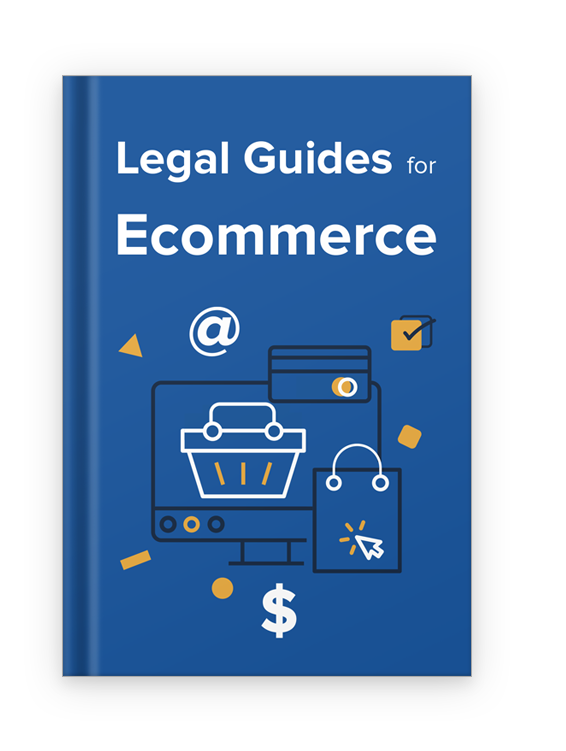About
On this page
- 1. Terms and Conditions and Ecommerce Businesses
- 2. What Your Terms and Conditions Agreement Should Include
- 2.1. Limitation of Liability
- 2.1.1. Laws on Limitation of Liability Clauses
- 2.2. Different Types of Damages
- 2.2.1. Limiting Liability to a Specific Amount
- 2.3. Disclaimer of Warranties
- 2.3.1. Laws on Disclaimers of Warranties
- 2.3.2. Provided "As Is"
- 2.4. Returns and Refunds
- 2.5. Delivery Information
- 2.5.1. Delivery Options
- 2.6. Shipping Costs
- 2.7. Timescales for Dispatch and Delivery
- 2.8. Delivery Restrictions
- 2.9. Customs and Duties
- 2.10. Payment Methods
- 2.11. Other Information
- 3. Where to Display Your Terms and Conditions on Your Ecommerce Store
- 3.1. On Your Website
- 3.2. Within Your Mobile App
- 3.3. Other Locations
- 4. Case Study
Terms and Conditions and Ecommerce Businesses
The main function of a "Terms and Conditions" agreement is to set out what your customers can expect from your company, and what you expect from them in return.
If properly presented and actively agreed to, Terms and Conditions represent a contract between you and your customers. If carefully drafted, this contract has legal effect and will be enforced by the courts in the event of a legal dispute.
Unlike a Privacy Policy, Terms and Conditions aren't a legal requirement. But having a clear and robust set of Terms and Conditions in place is an extremely good idea.
Having a strong set of Terms and Conditions in place means that you can:
- Set the limits of your company's legal liability
- Set the terms of your product warranties
- Manage your customers' expectations
What Your Terms and Conditions Agreement Should Include
What you include in your Terms and Conditions will depend on the nature of your business and where your business is based.
Whereas there are specific legal requirements for what appears in your Privacy Policy, this is not really true of your Terms and Conditions. You are free to write whatever you want, but that doesn't necessarily mean it will all benefit you.
Writing a Terms and Conditions agreement is a balancing act. You want to protect your company's interests, but you also need to be fair to your customers. If you're asking your customers to agree to something that's fair for both parties, your Terms and Conditions agreement is far more likely to be effective and legally enforceable.
Limitation of Liability
A limitation (or exclusion) of liability is a way to protect your business against legal claims.
Selling your customers products in your ecommerce store means that you're entering into a contract with them. Every contract involves some degree of risk. Businesses can make mistakes that cause their customers injuries and costs (losses).
Obviously you will take care to ensure that you don't cause your customers any losses. But you only want to be liable for a fair proportion of the damage if something goes wrong. Your customers should be buying your products with this understanding.
In theory, liability can be either:
- Limited to a particular sum. You accept that if someone suffers a loss and it's your company's fault, you will pay damages - but only, say, $100.
- Excluded altogether. If someone suffers a loss, even where it's clearly your company's fault, you won't pay damages at all.
In practice, the courts will refuse to enforce limitation or exclusion clauses which are unfair or unconscionable.
Here's an example of a typical limitation of liability clause from Hobby Lobby's Terms of Use:
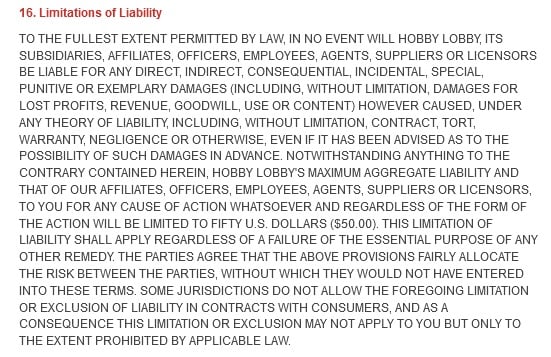
16. Limitations of Liability
TO THE FULLEST EXTENT PERMITTED BY LAW, IN NO EVENT WILL HOBBY LOBBY, ITS SUBSIDIARIES, AFFILIATES, OFFICERS, EMPLOYEES, AGENTS, SUPPLIERS OR LICENSORS BE LIABLE FOR ANY DIRECT, INDIRECT, CONSEQUENTIAL, INCIDENTAL, SPECIAL, PUNITIVE OR EXEMPLARY DAMAGES (INCLUDING, WITHOUT LIMITATION, DAMAGES FOR LOST PROFITS, REVENUE, GOODWILL, USE OR CONTENT) HOWEVER CAUSED, UNDER ANY THEORY OF LIABILITY, INCLUDING, WITHOUT LIMITATION, CONTRACT, TORT, WARRANTY, NEGLIGENCE OR OTHERWISE, EVEN IF IT HAS BEEN ADVISED AS TO THE POSSIBILITY OF SUCH DAMAGES IN ADVANCE. NOTWITHSTANDING ANYTHING TO THE CONTRARY CONTAINED HEREIN, HOBBY LOBBY'S MAXIMUM AGGREGATE LIABILITY AND THAT OF OUR AFFILIATES, OFFICERS, EMPLOYEES, AGENTS, SUPPLIERS OR LICENSORS, TO YOU FOR ANY CAUSE OF ACTION WHATSOEVER AND REGARDLESS OF THE FORM OF THE ACTION WILL BE LIMITED TO FIFTY U.S. DOLLARS ($50.00). THIS LIMITATION OF LIABILITY SHALL APPLY REGARDLESS OF A FAILURE OF THE ESSENTIAL PURPOSE OF ANY OTHER REMEDY. THE PARTIES AGREE THAT THE ABOVE PROVISIONS FAIRLY ALLOCATE THE RISK BETWEEN THE PARTIES, WITHOUT WHICH THEY WOULD NOT HAVE ENTERED INTO THESE TERMS. SOME JURISDICTIONS DO NOT ALLOW THE FOREGOING LIMITATION OR EXCLUSION OF LIABILITY IN CONTRACTS WITH CONSUMERS, AND AS A CONSEQUENCE THIS LIMITATION OR EXCLUSION MAY NOT APPLY TO YOU BUT ONLY TO THE EXTENT PROHIBITED BY APPLICABLE LAW.
You'll notice that many Limitation of Liability clauses are in all capital letters. This convention originates partly from the requirement in the Uniform Commercial Code (UCC) that certain terms are made "conspicuous."
The reality is that the tendency to write in a large block of all capital letters actually makes these clauses harder to read for many consumers. There are other options (bold type, bullet points) for making certain contractual terms conspicuous. You don't have to use all caps.
Let's break Hobby Lobby's clause down. There are several statements here which we can explore in turn.
- To the fullest extent permitted by law
- Direct, indirect, consequential, incidental, special, punitive or exemplary damages
- Limited to $50
Laws on Limitation of Liability Clauses
What does Hobby Lobby mean by "to the fullest extent permitted by law"?
Any contract is only useful insofar as it will be enforced by a court. A court is less likely to enforce a contract that it deems unconscionable or unfair. In some countries, courts are stricter in their interpretations of unconscionability than in others. It's harder for businesses to argue that their limitation clauses should be enforced.
In the U.S., there is some scope for courts to find that contractual terms are unconscionable under the Uniform Commercial Code § 2-302. This places some theoretical limits on what a contract can include.
In the UK, business to consumer contracts are governed by the Consumer Rights Act 2015. This law instructs courts not to enforce clauses that attempt to exclude liability for death or personal injury caused by negligence. In fact, it's almost impossible to exclude liability for any effects of negligence under this law. Liability for negligence can realistically only be limited.
Here's part of eBay's limitation of liability clause in its User Agreement for UK users:
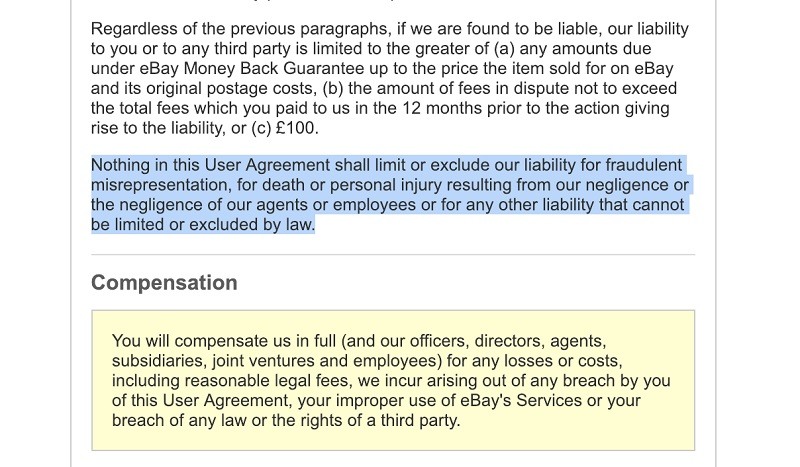
Regardless of the previous paragraphs, if we are found to be liable, our liability to you or to any third party is limited to the greater of (a) any amounts due under eBay Money Back Guarantee up to the price the item sold for on eBay and its original postage costs, (b) the amount of fees in dispute not to exceed the total fees which you paid to us in the 12 months prior to the action giving rise to the liability, or (c) £100.
Nothing in this User Agreement shall limit or exclude our liability for fraudulent misrepresentation, for death or personal injury resulting from our negligence or the negligence of our agents or employees or for any other liability that cannot be limited or excluded by law.
Here, eBay is acknowledging that liability for certain things can't be excluded under UK law.
Here's how Macy's acknowledges the differences between jurisdictions:
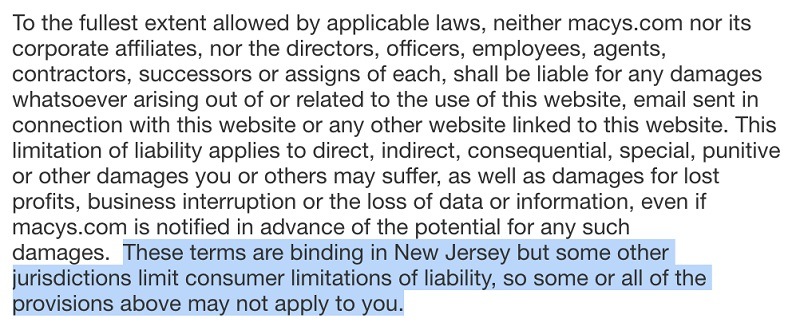
To the fullest extent allowed by applicable laws, neither macys.com nor its corporate affiliates, nor the directors, officers, employees, agents, contractors, successors or assigns of each, shall be liable for any damages whatsoever arising out of or related to the use of this website, email sent in connection with this website or any other website linked to this website. This limitation of liability applies to direct, indirect, consequential, special, punitive or other damages you or others may suffer, as well as damages for lost profits, business interruption or the loss of data or information, even if macys.com is notified in advance of the potential for any such damages. These terms are binding in New Jersey but some other jurisdictions limit consumer limitations of liability, so some or all of the provisions above may not apply to you.
Different Types of Damages
What does Hobby Lobby mean by "direct, indirect, consequential, incidental, special, punitive or exemplary damages"?
The purpose of limiting liability is to limit the amount that your company will pay out in damages. "Damages" refers to the money paid out to compensate for a loss.
Broadly speaking:
- Direct damages cover the things that a reasonable person might see as obvious losses, directly resulting from a breach of contract.
- Indirect, special or consequential damages are the other losses that might result from a breach of contract.
For example, a tech company supplies a faulty hard drive that damages a customer's computer. The customer uses his computer for work and is therefore unable to work for one week.
The cost of the damage to the computer itself is a direct loss and would be compensated by direct damages.
The loss of one week's operating profits is an indirect loss. If compensated, this would be compensated by consequential (also known as "special" or "indirect") damages.
Most companies, like Hobby Lobby, try to cover all bases. Some express themselves slightly differently, but they are aiming for the same effect.
Here's how Walmart puts it:
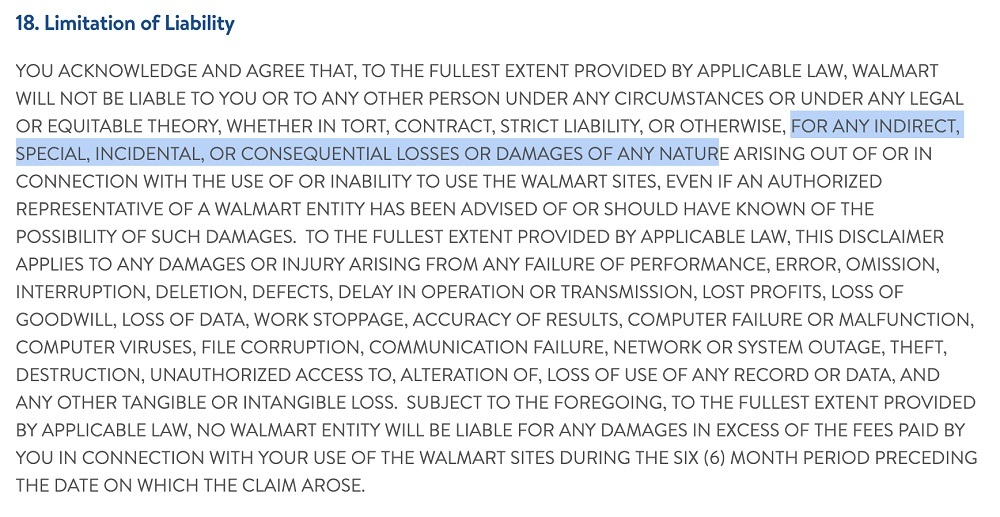
18. Limitation of Liability
YOU ACKNOWLEDGE AND AGREE THAT, TO THE FULLEST EXTENT PROVIDED BY APPLICABLE LAW, WALMART WILL NOT BE LIABLE TO YOU OR TO ANY OTHER PERSON UNDER ANY CIRCUMSTANCES OR UNDER ANY LEGAL OR EQUITABLE THEORY, WHETHER IN TORT, CONTRACT, STRICT LIABILITY, OR OTHERWISE, FOR ANY INDIRECT, SPECIAL, INCIDENTAL, OR CONSEQUENTIAL LOSSES OR DAMAGES OF ANY NATURE ARISING OUT OF OR IN CONNECTION WITH THE USE OF OR INABILITY TO USE THE WALMART SITES, EVEN IF AN AUTHORIZED REPRESENTATIVE OF A WALMART ENTITY HAS BEEN ADVISED OF OR SHOULD HAVE KNOWN OF THE POSSIBILITY OF SUCH DAMAGES. TO THE FULLEST EXTENT PROVIDED BY APPLICABLE LAW, THIS DISCLAIMER APPLIES TO ANY DAMAGES OR INJURY ARISING FROM ANY FAILURE OF PERFORMANCE, ERROR, OMISSION, INTERRUPTION, DELETION, DEFECTS, DELAY IN OPERATION OR TRANSMISSION, LOST PROFITS, LOSS OF GOODWILL, LOSS OF DATA, WORK STOPPAGE, ACCURACY OF RESULTS, COMPUTER FAILURE OR MALFUNCTION, COMPUTER VIRUSES, FILE CORRUPTION, COMMUNICATION FAILURE, NETWORK OR SYSTEM OUTAGE, THEFT, DESTRUCTION, UNAUTHORIZED ACCESS TO, ALTERATION OF, LOSS OF USE OF ANY RECORD OR DATA, AND ANY OTHER TANGIBLE OR INTANGIBLE LOSS. SUBJECT TO THE FOREGOING, TO THE FULLEST EXTENT PROVIDED BY APPLICABLE LAW, NO WALMART ENTITY WILL BE LIABLE FOR ANY DAMAGES IN EXCESS OF THE FEES PAID BY YOU IN CONNECTION WITH YOUR USE OF THE WALMART SITES DURING THE SIX (6) MONTH PERIOD PRECEDING THE DATE ON WHICH THE CLAIM AROSE.
Limiting Liability to a Specific Amount
What does Hobby Lobby mean by "liability [...] will be limited to fifty US dollars"?
In theory, you can attempt to exclude liability completely - to state that your company will pay no damages whatsoever. But there is a danger, sometimes even an inevitability, that this will be seen as unconscionable.
Getting your limitation of liability clause thrown out of court would be a very bad thing.
Many companies, including Hobby Lobby, choose to cap their total liability at a specific amount. Hobby Lobby chooses $50. Tracking Wonder chose $100 in its amusingly-titled limitation of liability clause:
![]()
THE "LIMITATION OF LIABILITY" CLAUSE, OR, THE ONE WHERE YOU AGREE NOT TO SUE OUR PANTS OFF
You agree that under no circumstances shall we be liable for direct, indirect, incidental, consequential, special, punitive, exemplary, or any other damages arising out of your use of the Site or Service. Additionally, Center to Page is not liable for damages in connection with (i) any failure of performance, error, omission, denial of service, attack, interruption, deletion, defect, delay in operation or transmission, computer virus or line or system failure; (ii) loss of revenue, anticipated profits, business, savings, goodwill or data; and (iii) third party theft of, destruction of, unauthorized access to, alteration of, or use of your information or property, regardless of our negligence, gross negligence, failure of an essential purpose and whether such liability arises in negligence, contract, tort, or any other theory of legal liability. The foregoing applies even if Center to Page has been advised of the possibility of or could have foreseen the damages. In those states that do not allow the exclusion or limitation of liability for the damages, our liability is limited to the fullest possible extent permitted by law. In no event shall Center to Page's cumulative liability to you exceed the total purchase price of the Service you have purchased from Center to Page, and if no purchase has been made by you Center to Page's cumulative liability to you shall not exceed $100.
Limiting your liability is much more likely to be seen as reasonable than excluding it altogether.
Disclaimer of Warranties
A warranty is a promise or a guarantee about the quality of a product or service. If you make a promise about your products, a customer can hold you to it. A disclaimer of warranties is a way for your ecommerce store to avoid making certain promises automatically.
Here's an example of a disclaimer of warranties from Shop.com:

DISCLAIMER OF WARRANTIES.
USE OF THE SITE IS AT YOUR OWN RISK. THE SHOP.COM SITE, FEATURES, PRODUCTS, CONTENT AND MATERIALS MADE AVAILABLE ON, IN CONJUNCTION WITH OR THROUGH THE SITE ARE PROVIDED TO YOU ON AN "AS IS" AND "AS AVAILABLE" BASIS WITHOUT WARRANTIES OF ANY KIND EITHER EXPRESS OR IMPLIED. TO THE MAXIMUM EXTENT PERMITTED BY LAW SHOP.COM DISCLAIMS ALL WARRANTIES, STATUTORY, EXPRESS OR IMPLIED, INCLUDING BUT NOT LIMITED TO, IMPLIED WARRANTIES OF MERCHANTABILITY AND FITNESS FOR A PARTICULAR PURPOSE, NON-INFRINGEMENT, TITLE, QUIET ENJOYMENT, DATA ACCURACY AND SYSTEMS INTEGRATION.
Let's break this down. The disclaimer says two things of particular interest:
- To the maximum extent permitted by law
- Provided "As is"
Laws on Disclaimers of Warranties
As is the case with limitation of liability clauses, disclaimers of warranties take different legal effect in different places. They also attract close scrutiny from the courts.
In the U.S., the Uniform Commercial Code (UCC) § 2-314 imposes two "implied" warranties on all goods:
-
Merchantability, which applies to professional merchants (businesses) only. The warranty of merchantability guarantees that goods are:
- Of average quality (at a minimum),
- Labeled and packaged properly, and
- Fit for purpose
-
Fitness for a particular purpose, which applies to all sellers
The law means that, by default, businesses are assumed to have made these promises about their products.
It is possible to disclaim these warranties in most states. This means that you will not be making these promises about your goods. But you must be specific about this in your terms.
The implied warranties cannot be disclaimed under the laws of the some states, including:
There are some heavy restrictions on the extent to which a disclaimer of an implied warranty is valid in some other states, including:
Some other states require specific wording to be used in a disclaimer - for example the use of the word "merchantability."
Here's an example of a company explicitly disclaiming different types of warranties:

Informational Content Disclaimer
THE INFORMATION PROVIDED ON THIS WEB SITE IS PROVIDED "AS IS" AND ALL WARRANTIES, EXPRESS OR IMPLIED, ARE DISCLAIMED, INCLUDING, BUT NOT LIMITED TO, ANY IMPLIED WARRANTIES OF MERCHANTABILITY, MERCHANTABILITY OF ANY COMPUTER PROGRAM, FITNESS FOR A PARTICULAR PURPOSE, ACCURACY OF INFORMATIONAL CONTENT, OR SYSTEM INTEGRATION, OR NON-INFRINGEMENT. VYZE, INC.'S MAXIMUM LIABILITY FOR ANY INACCURATE INFORMATION AND YOUR SOLE AND EXCLUSIVE REMEDY FOR ANY CAUSE WHATSOEVER, SHALL BE LIMITED TO THE AMOUNT PAID BY YOU FOR THE INFORMATION RECEIVED (IF ANY). VYZE, INC. IS NOT LIABLE FOR ANY INDIRECT, SPECIAL, INCIDENTAL, LOSS OF BUSINESS, LOSS OF PROFITS OR CONSEQUENTIAL DAMAGES, WHETHER BASED ON BREACH OF CONTRACT, BREACH OF WARRANTY, TORT, NEGLIGENCE, PRODUCT LIABILITY OR OTHERWISE, EVEN IF ADVISED OF THE POSSIBILITY OF SUCH DAMAGE.
There is no obligation to provide an express (written) warranty in U.S. federal law. But where a warranty is provided, the Magnuson-Moss Warranty Act forces that warranty to guarantee certain things. You should familiarize yourself with these requirements if you're planning to offer your customers a warranty and you're based in the United States.
The situation is very different in the EU, where consumer protection is a lot stronger.
In the EU, the Sale of Goods and Associated Guarantees Directive means that all consumer goods sold in the EU must:
- Match the description given,
- Be fit for purpose, and
- Be of satisfactory quality
EU law also guarantees a 14-day cancellation period for goods bought online (for any reason) and a 2-year guarantee for all consumer goods. Some EU countries go above and beyond this. Technically, the legal guarantee extends to 6 years in parts of the UK.
It's generally not possible to disclaim such statutory consumer rights in EU countries. If an EU company inserts a disclaimer of warranties in its Terms and Conditions that does not comply with consumer law, it will be disregarded by the courts.
Provided "As Is"
What does Shop.com mean by "as is"?
Saying that a product is sold "as is" is one way of disclaiming the warranties of merchantability and fitness for purpose. Sometimes this is accompanied by the term "with all faults." The phrase "final sale" can have a similar effect.
Here's a disclaimer of warranties from Aaron Equipment:

6. DISCLAIMER OF WARRANTIES
- ALL GOODS ARE PURCHASED BY THE PURCHASER "AS IS" AND "WITH ALL FAULTS"
- SELLER MAKES NO REPRESENTATION OR WARRANTY, EXPRESS, OR IMPLIED, INCLUDING BUT NOT LIMITED TO WARRANTIES OF MERCHANTABILITY OR FITNESS FOR A PARTICULAR PURPOSE, WARRANTY AGAINST INFRINGEMENT OF INTELLECTUAL PROPERTY RIGHTS OF A THIRD PARTY OR ANY OTHER MATTER WITH RESPECT TO THE GOODS.
- Any affirmation of fact or promises made by Seller or its employees or representatives shall not be deemed to create an express warranty that the Goods or services shall conform to such affirmation or promise. Any descriptions, samples and specifications with respect to goods offered for sale herein are not warranted by Seller to be accurate or complete. If a model or sample was shown to Purchaser, such model or sample was used merely to illustrate the general type and quality of goods sold by Seller and not to represent that the Goods would necessarily conform to such model or sample. Any description is for the sole purpose of identifying the Goods and no affirmation, promise, description, sample or model shall be deemed part of the basis of the bargain. SELLER STRONGLY RECOMMENDS THAT PURCHASER CONDUCT AN ON-SITE INSPECTION OF THE GOODS SOLD HEREUNDER. SELLER SHALL NOT BE RESPONSIBLE FOR THE CONSEQUENCES OF PURCHASER'S FAILURE TO INSPECT THE GOODS OR FOR ANY INACCURACIES, INSUFFICIENCIES, OR OMISSIONS IN SUCH DESCRIPTIONS, SAMPLES AND/OR SPECIFICATIONS. The employees or representatives of Seller are not authorized to make any statement or representation as to the quality, character, size, condition, quantity, etc. of the goods offered for sale inconsistent with these Terms and Conditions. Any such statements made will not be binding on Seller or be grounds for any subsequent claim.
You can see that goods are sold "as is" and "with all faults." The customer is advised to inspect the goods on-site before purchase. This is basically what is implied by selling something "as is" - the buyer can take it or leave it.
Such a clause would not apply in some states, or jurisdictions such as the EU, for goods bought online. It's assumed that the buyer hasn't had the opportunity to inspect the product until it's delivered.
It's also not possible for a business in the states listed above or the EU to sell faulty goods and refuse a refund.
We'll be looking at other types of disclaimers in Chapter 6.
Returns and Refunds
As the online marketplace grows, competition increases as well. Customers expect a good level of service, and their repeat business depends on you providing it.
Having a Return and Refund Policy means that your customers know where they stand if something goes wrong with one of your products. And if they don't know, you can point to the policy that they agreed to when they made the purchase.
It's also reassuring for your customers to know that they're covered if something goes wrong.
We'll discuss your Return and Refund Policy in more detail in the next chapter. At this point, it will suffice to say this: if you're going to have a Return and Refund Policy (and it's strongly recommended that you do), it's important that you ask your customers to agree to it before they make a purchase.
Your Return and Refund Policy should be a separate agreement, but should also be linked to and referenced within your Terms agreement. This way, when getting users to agree to your terms, they will also be agreeing to your return policy by default.
Here's an example of how you can mention and link to a Return and Refund Policy within a Terms agreement:

5. Returns, Cancellations and Substitutions
5.1 We offer a 30-day money back guarantee, please refer to Returns and refunds. Some products are excluded from the Guarantee and are clearly marked by a † next to the product name. In the unlikely event that you receive faulty or damaged goods, please refer to our Returns and refunds section.
5.2 Sometimes the product specifications from the manufacturer may change, in which case we will do our best to offer you a similar alternative. We may experience problems with the supply of certain products and may therefore supply a substitute of the same or better quality at the same price. If you are not happy with the replacement or substitute you can return it in accordance with our 30-day money back guarantee. Where applicable, you may cancel your order in accordance with your rights under the Consumer Contracts (Information, Cancellation & Additional Charges Regulations (see the Returns and refunds page for further details
5.3 All sizes and measurements are approximate but we do try to make sure that they are as accurate as possible.
Some basic information and a summary is provided about the Return and Refund Policy as well as a link to the full policy.
Delivery Information
Having your delivery information as part of (or otherwise incorporated into) your Terms and Conditions is another good way to manage your customers' expectations.
If any disputes arise, you can also demonstrate that your customers have agreed to your delivery information by having agreed to your Terms and Conditions.
Delivery Options
You should include details about your customers' delivery options, as well as any conditions you place on these. This can include different timeframes, prices, and limitations.
Here's an example from Michaels' Shipping Policy. This is just an excerpt of its full, very informative policy:
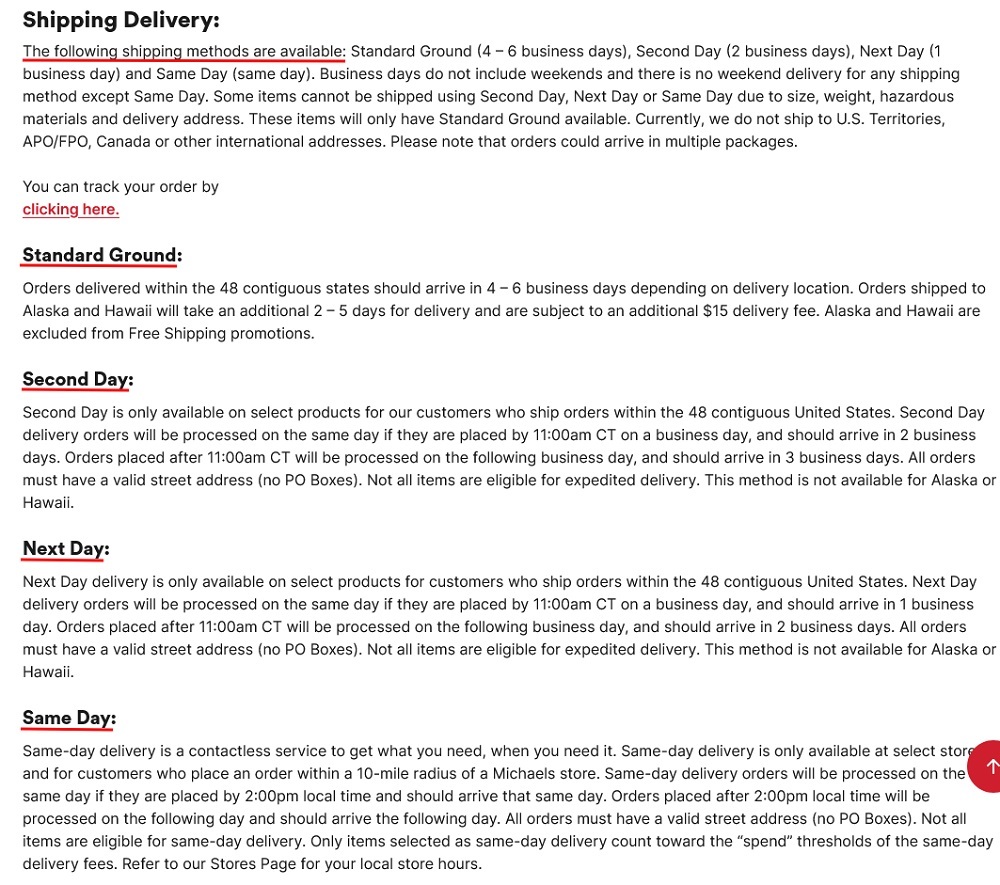
Don't forget to include cut-off times:

Shipping Costs
Make sure you include the costs for different shipping options so that customers are clear about this from the outset.
Here's an example from Michaels:
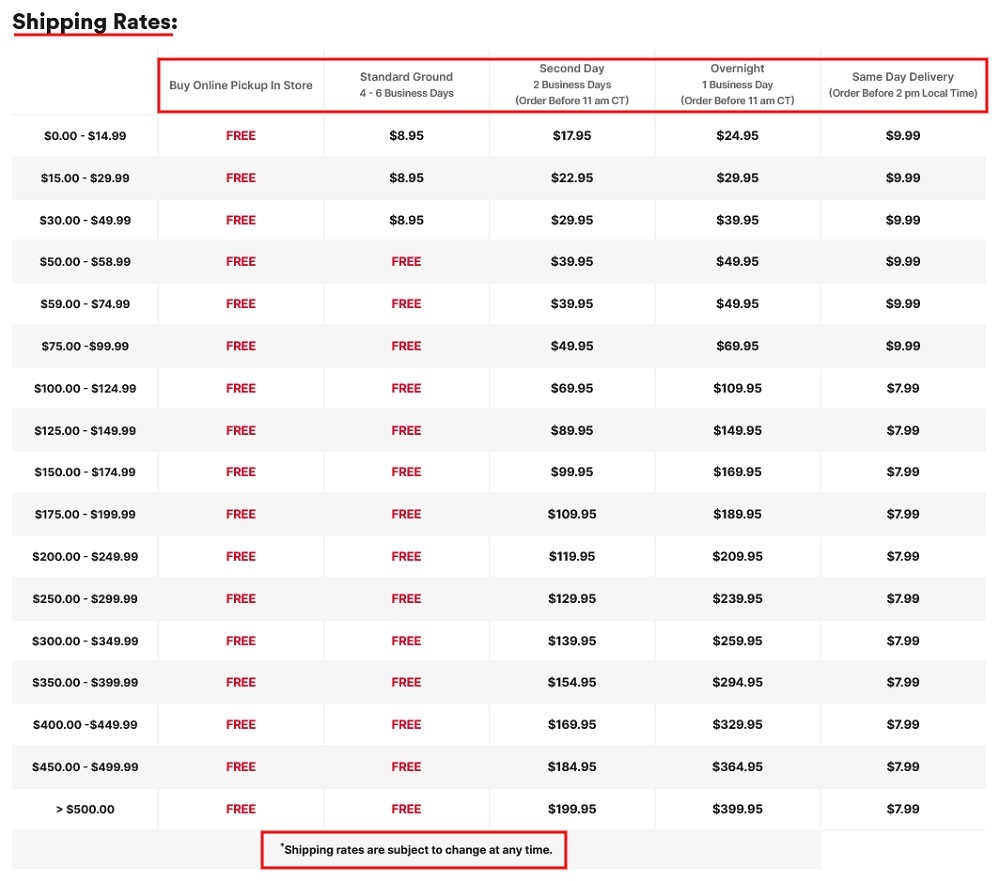
Note how it also includes a note at the bottom that shipping rates are subject to change at any time. This is smart to do so you're covered in case shipping costs change and you need to adjust them to not take a huge loss.
Timescales for Dispatch and Delivery
You can use shipping information to make your timescales clear - your dispatch time (when you send something) and your delivery time (when it will arrive).
Here's an example of how this can look:
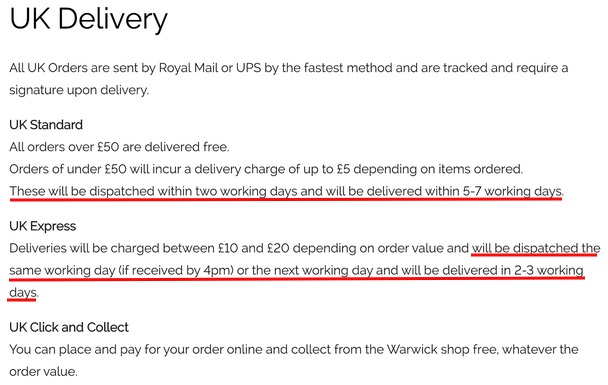
Delivery Restrictions
There may be some places that you can't deliver to, or some items that you can't deliver to certain places.
Here's how Amazon UK covers this:
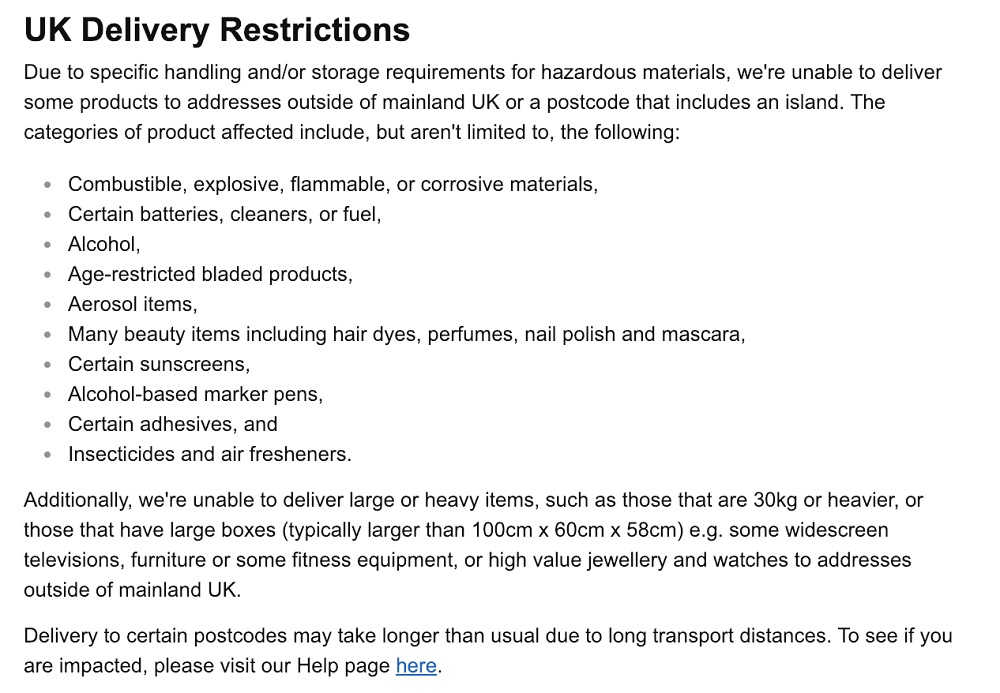
Customs and Duties
Issues can arise when shipping internationally. Many countries place additional tariffs on certain goods at the border. This might be a surprise to a customer who has been quoted a particular price for delivery and then finds that their customs office has put an extra sum on top.
Many ecommerce stores handle this by saying that the customer is responsible for additional taxes or duties incurred when shipping internationally.
Here's an example of how you can address this issue:

Payment Methods
You can also include reference to the forms of payment you accept, the terms on which a customer will be charged, and what will happen if a payment fails. This is particularly important if you're offering a subscription service.
Here's an example from meal kit service Blue Apron:
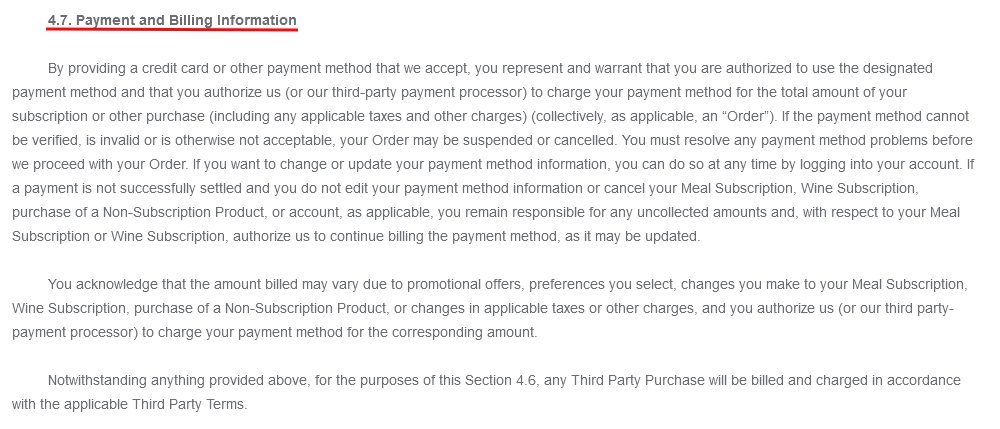
Other Information
In addition to the above, there are some other sections you can consider including in your Terms and Conditions:
- A copyright and trademark section that establishes your intellectual property rights
- A set of disclaimers relative to the products you sell (we'll discuss this in more detail in Chapter 6)
- A governing law clause that sets the jurisdiction in which legal claims will be heard
If you allow your visitors to contribute user generated content to your website, for example in a comments section under blog posts, your Terms and Conditions can also be used to manage this. You can set out:
- The type of content that visitors are permitted to post
- What they cannot post
- The conditions under which a person might be banned from your website
- An indemnity or "hold harmless" clause that protects your company from defamation claims
- How visitors can submit information about alleged copyright violations under the Digital Millennium Copyright Act
Here's how Behr lists out what content cannot be submitted:
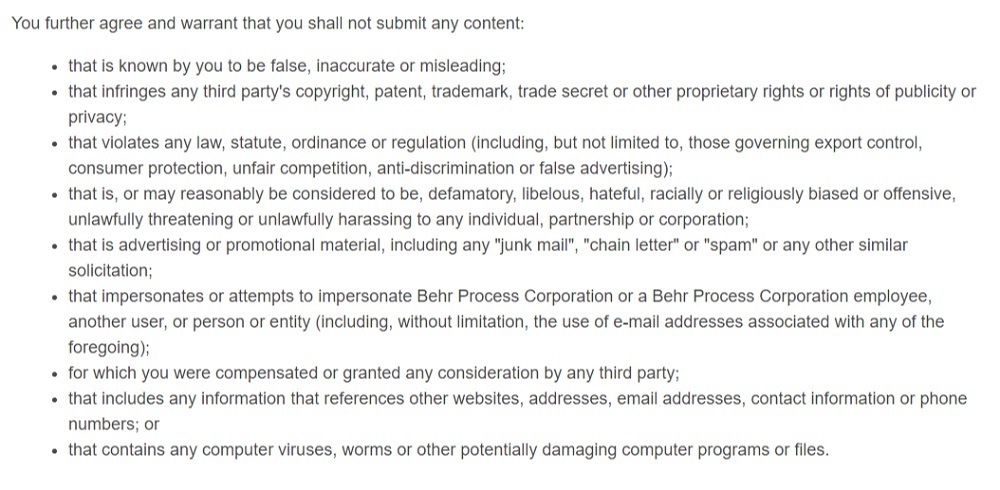
It's not necessary to create a separate agreement for something like this, but mentioning it within a clause in your Terms and Conditions is a good idea.
Where to Display Your Terms and Conditions on Your Ecommerce Store
Terms and Conditions can fail to take legal effect if it's found that your customers did not have a good enough opportunity to examine them or didn't properly agree to them. There's a whole area of case law about contracts that were not enforced by the courts for this reason.
Ecommerce stores have no excuse to end up in this situation. You aren't delivering your terms on a sign hidden behind a counter or a letter that gets lost in the mail. You can make sure your customers have read and agreed to your terms before they make a purchase.
On Your Website
You'll want to put a link to your Terms and Conditions in your website's footer so you can make it available on every page of your website.
Here's an example from The Broken Token:

You also need to present your Terms and Conditions in clickwrap form before your customer makes a purchase or signs up for an account. Basically, any time a contract is formed between you and the user.
Request that your users proactively check a box to show that they have read and agree with your Terms and Conditions.
Here's an example of a standard click to accept checkbox you can use:

The alternative is what's called a "browsewrap" agreement, where the customer is deemed to have agreed to your Terms and Conditions merely by using your website or buying a product. This is not a safe way to ensure that your customer really agrees to your terms, and you risk not having your terms be enforceable in court.
Within Your Mobile App
Since mobile apps don't have site footers, you'll need a slightly different approach here. That's where your in-app menus come into play. Display your Terms agreement within a menu in your app's interface.
Here's an example of a Settings menu with legal agreement links:

You can also present it to users at download/sign-up, when creating an account with your app, requesting that they tap a button to show agreement. Here's an example:
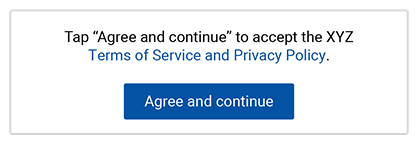
Other Locations
You should make reference to your Terms and Conditions in other legal agreements such as your Privacy Policy. This cross-linking helps ensure that it's even easier for users to find all of your legal agreements, since if they find even one, they find the others by default. This also works to ensure agreement to all, since agreeing to one by default will get agreement to the others.
Here's an example of something you can include in your Privacy Policy to integrate your Terms agreement:

Case Study
Joshi's Jogging is a fitness products company based in the United States. It ships domestically, offering a range of delivery options, and internationally to Canada and the EU.
Joshi's Jogging should create a Terms and Conditions that:
- Links visitors to its Privacy Policy and any other policies that they should read
- Limits its liability for any losses resulting from the use of its products
- Disclaims the warranties of merchantability and fitness for purpose under U.S. law
- Explains that the disclaimers and limitations it sets out are valid to the fullest extent permitted by law
- Sets out the associated costs that customers might incur through delivery
- Explains that overseas customers are responsible for paying any customs duties
- Sets out, or points to, the store's Return and Refund Policy. This policy should be compliant with the laws of the jurisdictions in which it operates. (We'll cover this in more detail in the next chapter.)
